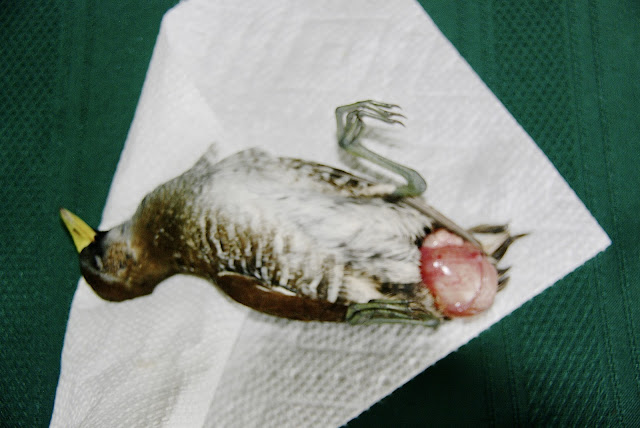On 19 May 2025 I was birding Wilkins Field in Fredericton North. After seeing such interesting birds as a Great Egret and a singing Willow Flycatcher I met one of the birders who frequents that birding spot. In the course of our chat he offered that he had seen a dead Sora down the trail and it ‘had its guts hanging out’. Being a former veterinary pathologist, of course I was interested.
The body of the Sora was in good condition, having died only recently. It was immediately obvious that this bird was not killed by a predator or accidentally run over by a motor vehicle. A few vehicles and 4-wheelers do go through there and the normally locked gate at the entrance was open. On observation the cause of death was obvious - egg binding.
What is egg binding? Egg binding occurs in avian species when for various reasons the bird is unable to pass the egg. It is seen periodically in poultry and caged birds. I have never seen or heard of it in wild birds and reports are rare. In order to understand it, I must start with a brief description of the process of egg production.
In egg production the mature ovum (undeveloped egg) moves from the ovary into the oviduct. As it moves down the oviduct it becomes fertilized by the male sperm and then more developed, gaining size and developing its albumen and shell. When formed it passes from the oviduct into the cloaca. From there the female lays the egg into the nest. The cloaca is a cavity in the posterior of the avian species into which the urinary, digestive and reproductive tracts open.
In egg-binding the egg lodges in the oviduct and the bird cannot pass it into the cloaca. This situation becomes critical and causes great stress to the bird often leading to death. Occasionally treatment with warm baths, massaging and changes in diet can help in domestic birds but this is not possible in wild birds.
What causes egg-binding? Sometimes there appears to be no obvious cause at all. We often can, however, predict the cause from our experience with caged birds and poultry. One important cause is cold, damp conditions during the laying season. We certainly had that in May here in New Brunswick, having had a lot of rain and cold weather. This would lead to poor nutrition and it could affect the functioning of the oviducts. This could result in spasms and cramping of the muscles in the oviduct. This could result in slow movement of the egg down the oviduct or even stasis. This could then result in excessive amounts of albumen being laid down or extra layers of shell being applied. This could produce an extra large egg which would be difficult to pass. The spasms of the muscles could cause the egg to fail to move down and into the cloaca. Spasms could also cause extra mucus to be produced which can lead to total obstruction. The production of further ova above the obstruction can lead to further impaction. Another cause is atony or paralysis of the oviduct which results in a normal, fully developed egg being arrested in its movement down the oviduct and into the cloaca. The insufficient muscular activity would result in stasis and egg binding. Stasis of the egg in the oviduct leads to excessive straining by the bird to eject the egg. With no movement of the egg this can lead to prolapse of the oviduct into the abdomen or prolapse of the cloaca into the exterior.
Dietary deficiencies can also be a cause. One would assume that a wild bird would be able to find an adequate diet in a place in which it has previously nested and which has not been altered by humankind, which is the case at Wilkins Field. The body condition of the bird was normal so it was not starving.
The Sora in this case had egg binding and prolapse of the oviduct and cloaca to the exterior. This bird obviously had been in distress for one to two days. It unfortunately had suffered greatly during that time. If it had been found before its death it would have been unlikely we could have saved it through surgery. I extracted the egg from the prolapsed tissue and it was a normal size (30.1 mm) and colour. Its shell was very soft and its shape was normal. See photos below.
This unfortunate female Sora died of egg binding which led to prolapse of the oviduct and cloaca and subsequent death from stress and dehydration. It probably had a nest in which there were other eggs which then would have been predated. The Sora is present in a few numbers at Wilkins field but the surviving male may not have been able to find another female with which to carry on breeding.
This is an unusual event in the breeding history of the Sora but we are fortunate it is rare and probably does not significantly affect the overall population numbers. An interesting case, but an unfortunate loss of a female Sora.




















